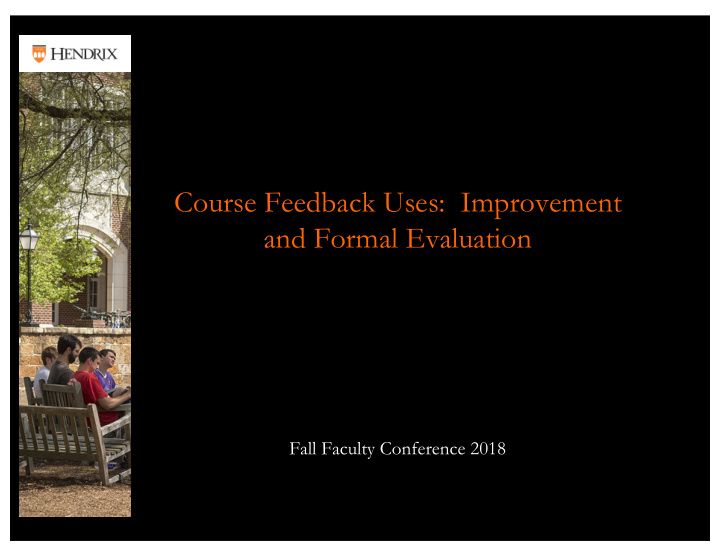



Course Feedback Uses: Improvement and Formal Evaluation Fall Faculty Conference 2018
Student Course Feedback
Student Course Feedback Conversations with Students – The Basics Tell your students: • You value honest and constructive feedback. • You are interested in suggestions concerning how you can improve the course the next time you teach it. • You will not be in the room when feedback is completed. • You will not see feedback until grades have been submitted. • Feedback is anonymous. • You are the primary audience for feedback, but it will also be seen by the administration during formal evaluations.
Student Course Feedback Conversations with Students – “Advanced” Topics • Remember that you are writing to your instructors. Unlike an online review site like “Rate My Professor,” your audience is not other students. • Specific constructive suggestions that focus on your learning are more useful that general comments. Both positive and negative feedback is helpful when very specific. • Comments that are not related to your learning diminish the value of your feedback. For example, it is not helpful to comment upon an instructor’s appearance or to include personal insults. • Give students examples of how to provide specific feedback. These examples work for qualitative questions or also for quantitative questions with follow-up comments.
Student Course Feedback Examples • My instructor just lectures. vs • My instructor just lectures and a short break would help me focus for the entire lecture. • My instructor just lectures but we need more time for student questions during lectures. • My instructor just lectures and I would learn more if I got more hands-on practice with the concepts.
Student Course Feedback Examples • The readings were redundant. vs • The readings were redundant. I didn’t understand why we read so many different articles on the same topic. • The readings were redundant. Could you offer more guidance on what we’re supposed to look for in the readings?
Student Course Feedback Examples • Discussions were awesome! vs • Discussions were awesome! I loved how you created an environment where students were willing to share their perspectives and disagree. • Discussions were awesome! It was really helpful that you made notes on the blackboard during the discussions.
Student Course Feedback How to Read Student Feedback Reports • Evaluate your class yourself before reading feedback summaries. • Read them when you are channeling receptiveness. • Scan for red flags and try to tease out useful data. • Do not read too much into the comments—stay calm. • When all responses have been read, review what you have learned about your class. • Prepare to demonstrate to others what you learned and how you have responded.
Student Course Feedback
Student Course Feedback • Sta rt with the quantitative charts and look for places where you think you should try to dig a little deeper. • Move to the qualitative comments and summarize how often particular issues were raised. • Compare how the quantitative and qualitative comments work together. • Also, of course, individual comments may speak to you even if they are not repeated by others.
Student Course Feedback
Student Course Feedback How does CoF read student feedback summaries? • Does the self-evaluation letter show reflection and change based on student feedback? • Summaries without reflection? L • Listing only a few superlative comments? L • Faculty comments fit the feedback summaries? J • Do the feedback summaries point to any major concerns that may need further attention? • Do those areas of concern involve basic level functions of good teaching? • Are the areas of concern dealt with in a productive way in the self-evaluation letter?
References • “Student Evaluations of Teaching,” Vanderbilt University Center for Teaching • “Providing Helpful Feedback to Your Instructors,” Center for Research on Learning and Teaching, University of Michigan • “How to Read a Student Evaluation,” David Perlmutter in the Chronicle of Higher Education • “Making Sense of Student Written Comments,” Karron Lewis in New Directions for Teaching and Learning • “Interpreting the Numbers: Using a Narrative to Help Others Read Student Evaluations of your Teaching Accurately,” Jennifer Franklin in New Directions for Teaching and Learning • Hendrix College Faculty Handbook
Recommend
More recommend